Partlow MRC 8000 Operating Manual

Form 3785 • Price $32.00
Edition 1 • © June 1997
ONE AND TWO PEN 12 INCH CIRCULAR CHART RECORDERS AND
RECORDING CONTROLLERS
MRC 8000
Installation, Wiring, Operation Manual
The Partlow Corporation • Two Campion Rd. • New Hartford, NY 13413 USA • 315-797-2222 • FAX 315-797-0403

Information in this installation, wiring, and operation manual is subject to change without notice. One manual is provided with each instrument at the time of
shipment. Extra copies are available at the price published on the front cover.
Copyright © June 1997, The Partlow Corporation, all rights reserved. No part of this publication may be
reproduced, transmitted, transcribed or stored in a retrieval system, or translated into any language in any form by any means without the written permission of the Partlow Corporation.
This is the First Edition of the MRC 8000 Recording Controller Manual. It was written and produced entirely on a desk-top-publishing system. Disk versions are available by written request to the Partlow Advertising and Publications Department.
We are glad you decided to open this manual. It is written so that you can take full advantage of the features of your new MRC 8000 microbased chart recording controller.
It is strongly recommended that Partlow equipped applications NOTE incorporate a high or low limit protective device which will shut
down the equipment at a preset process condition in order to preclude possible damage to property or products.
2

TABLE OF CONTENTS
SECTION 1 - GENERAL |
PAGE NUMBER |
|
1.1 |
Product Description |
5 |
SECTION 2 - INSTALLATION & WIRING |
|
|
2.1 |
Installation & Wiring |
8 |
2.2 |
Unpacking |
8 |
2.3 |
Location |
8 |
2.4 |
Mounting |
8 |
2.5 |
Preparation for Wiring |
10 |
2.6 |
Wiring Connections |
14 |
SECTION 3 - CONFIGURATION |
|
|
3.1 |
Configuration (Set Up) |
20 |
3.2 |
Configuration/Jumper Positioning |
21 |
3.3 |
Operation Summary |
21 |
3.4 |
Start Up Procedures |
22 |
3.5 |
Front Panel Operation |
22 |
SECTION 4 - OPERATION |
|
|
4.1 |
Off Control Mode |
39 |
4.2 |
Alarm Operation |
43 |
4.3 |
Tune Mode Operation |
44 |
SECTION 5 - SERVICE |
|
|
5.1 |
Service |
47 |
5.2 |
Changing Charts |
47 |
5.3 |
Changing Pens |
47 |
5.4 |
Calibration |
48 |
5.5 |
Test Mode Procedures |
53 |
5.6 |
Troubleshooting and Diagnostics (Error Code Definitions) |
57 |
APPENDICES |
|
|
A - Board Layouts and Jumper Positioning |
|
|
|
A-1 - Processor Board |
64 |
|
A-2 SPST Relay/SSR Driver Output Board |
65 |
|
A-3 Current Output Board |
66 |
B - Glossary |
67 |
|
C- Order Matrix |
69 |
|
D- Product Specifications |
70 |
|
E- Software Record/Reference Sheet |
73 |
|
Warranty |
75 |
|
3

FIGURES & TABLES
Figure 1-1 |
Recorder Description |
5 |
Figure 1-2 |
Recorder Display |
7 |
Figure 2-1 |
Installation Panel Dimensions Conduit Opening Locations |
9 |
Figure 2-2 |
Noise Suppression |
11 |
Figure 2-3 |
Noise Suppression |
11 |
Figure 2-4 |
Board and Terminal Locations |
14 |
Figure 2-5 |
AC Power Input |
15 |
Figure 2-6 |
Thermocouple Inputs |
15 |
Figure 2-7 |
RTD Inputs |
15 |
Figure 2-8 |
Milliamp, Volt and Millivolt Inputs |
16 |
Figure 2-9 |
Remote Setpoint Input VDC, mADC |
16 |
Figure 2-10 |
Digital Communications |
17 |
Figure 2-11A |
SPST Relay Output |
17 |
Figure 2-12 |
SSR Output |
18 |
Figure 2-13 |
Current Output |
18 |
Figure 2-14 |
24 VDC Power Supply Option |
19 |
Figure 2-15 |
Position Proportioning Control Output |
19 |
Figure 3-1 |
Keypad Features |
24 |
Figure 5-1 |
Changing Pens |
47 |
Table 3-1 |
Program Mode Configuration Procedure |
28 |
Table 3-2 |
Tune Mode Configuration Procedure |
35 |
Table 3-3 |
Enable Mode Configuration Procedure |
37 |
Table 5-1 |
Calibration Procedure |
49 |
Table 5-2 |
Test Procedures and Description |
54 |
FLOW CHARTS
Flow - Alarm Set Mode |
33 |
Flow - Calibration |
48 |
Flow - Enable Mode |
38 |
Flow - Program Mode |
25 |
Flow - Setpoint Select |
40 |
Flow - Standby |
43 |
Flow - Test |
53 |
Flow - Tune Mode |
34 |
4

Product Description 1.1
1.1.1 GENERAL
The instrument is a microprocessor based circular chart Recorder or Recording Controller capable of measuring, displaying, recording and controlling from a variety of inputs. Applications include temperature, level, pressure, flow and others. The instruments can be specified as either a single or as a dual pen model.
Recording, control functions, alarm settings and other parameters are easily entered via the keypad. All user's data can be protected from unauthorized changes by the Enable mode security system, and is protected against memory loss, as a result of AC power outage, by battery back-up.
The process sensor input for each pen is user configurable to directly connect to either thermocouple, RTD, mVDC, VDC, or mADC inputs. Changes in input type can easily be made by the user. Thermocouple and RTD linearization, as well as thermocouple cold junction compensation, are performed automatically. The instrument process variable inputs are isolated. An isolated 24 VDC regulated transmitter power supply can be provided in the instrument for use with up to two 4 to 20 mADC process sensor transducers.
The instrument can be ordered to operate on either 115 VAC or 230 VAC power at 50/60 Hz. The 230 VAC option includes a switch for selecting either 230 VAC or 115 VAC operation. The instrument is housed in a structural foam enclosure suitable for panel or surface mounting.
FIGURE 1-1
The number of keys and LED's will depend upon the configuration of individual unit.
5

1.1.2 RECORDING
The instrument records the selected process variable on a 12-inch circular chart. One box of standard charts is provided with each recorder. Charts are available in a wide selection of ranges. Chart rotation speed is programmable from 0.1 to 999.9 hours per revolution in 0.1 hour increments. The instrument can be ordered with one or two pens. Pen 1 is red and Pen 2 is green. Pens are the disposable fiber-tip type.
1.1.3 DISPLAYS
Each instrument has a digital display and status indicators for each pen (See Figure 1-1, page 5). On Recording Controllers, the display may be configured to display the Process Value, Process Value and Setpoint, Deviation from Setpoint only, Deviation and Setpoint, or Setpoint only. During configuration the display(s) is/are used to show the enabled modes of operation and the parameter codes.
The display at the left is for Pen 1, the display at the right is for Pen 2 (if provided). On Recorders, the display includes status indicators for Alarm 1 and Alarm 2, degrees C, degrees F, engineering units, and setpoint (for limits). On Recording Controllers, the display includes status indicators for Manual mode operation, Output 1, Output 2 , Alarm, degrees C, degrees F, engineering units, setpoint and minus sign. See Figure 1-2 ( page 7).
Display resolution is programmable for 0.1 or 1 degree for thermocouple and RTD inputs, and none, one, two or three decimal places for other input types.
1.1.4 CONTROL
The instrument can be provided with relay, solid state relay driver and milliamp DC outputs. Instruments can be programmed for on-off, time proportioning, current proportioning or position proportioning control depending upon the hardware present. Switching between the Control mode and the Manual mode of operation is easily accomplished with a dedicated key on the keypad. Switching is bumpless from the Control to the Manual mode, and while in manual, manipulation of proportional outputs is possible. Each pen of a dual pen recording controller is provided with its own AUTO/MANUAL key . Other standard control features include proportional control output limits, setpoint limits, anti-reset windup and a unique Automatic Transfer function. If configured, the Automatic Transfer function allows manual control of the proportional output until the process reaches the setpoint at which time the instrument will go into the Control (automatic) mode of operation.
1.1.5 ALARM
An Alarm indicator is standard for each pen. Two alarm functions are provided for each pen and the alarm indicator will light if either alarm for that pen is on. Alarm settings are programmable. Alarm type may be selected as process direct or reverse (high or low), deviation from setpoint direct or reverse, and deviation band open or closed within the band. Alarm outputs can be provided by assigning any relay(s) Single Pole/Single Throw (SPST) or Solid State Relay (SSR) driver to the respective alarm.
1.1.6 PROCESS VALUE RE-TRANSMISSION OUTPUT
If an instrument is specified with mADC current output(s), any of the outputs may be programmed to operate as a process value re-transmission output. The output is scaleable but
6
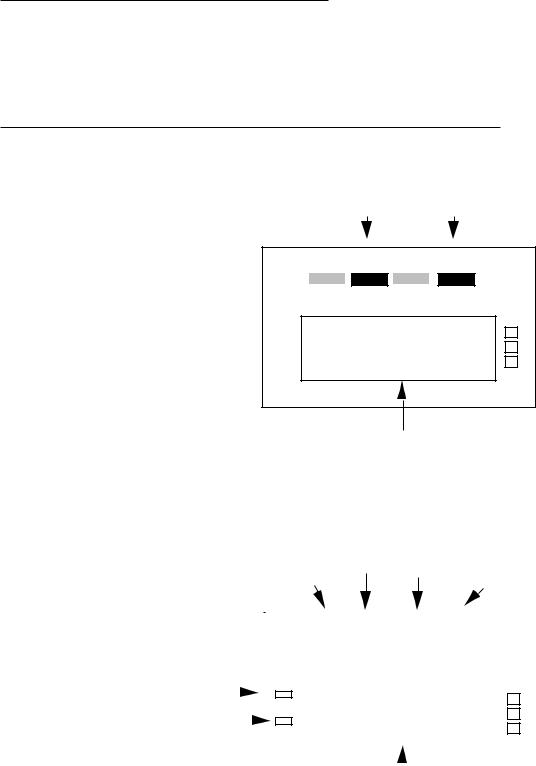
can not be used as a control output while assigned as a process value re-transmission output.
1.1.7 DIGITAL COMMUNICATIONS
The instrument can be ordered with a Digital Communications option that provides the capability of bi-directional communications with a supervisory computer. A dual pen instrument can have an individual address selected for each pen. Refer to the Communications Protocol Manual (Form 2878) for more details regarding the communications option. This manual is included with the unit when the communications option is specified.
FIGURE 1-2
Alarm 1 |
Alarm 2 |
RECORDERS:
ALRM1 ALRM2
Limit Setpoint 


Minus Sign 


C F U
Digital Display
RECORDING CONTROLLERS: |
Manual Output 1 |
Output 2 Alarm |
|||||||||||||||||||
|
|
|
|
|
|
|
|
|
|
|
|
|
|
|
|
|
|||||
|
|
|
|
MAN OUT1 OUT2 ALRM |
|||||||||||||||||
|
|
|
|
|
|
|
|
|
|
|
|
|
|
|
|
|
|
|
|
|
|
Setpoint |
|
|
|
|
|
SP |
|||||||||||||||
|
|
|
|
|
|
|
|
|
|
|
|
|
|
|
|
|
|
C |
|||
|
|
|
|
|
|
|
|
|
|
|
|
|
|
|
|
||||||
|
|
|
|
|
|
|
|
|
|
|
|
|
|
|
|
|
|
|
|
|
|
|
|
|
|
|
|
|
|
|
|
|
|
|
|
|
|
|
|
|
|
|
|
Minus Sign |
|
|
|
|
|
|
|
|
|
|
|
|
|
|
|
|
|
|
F |
||
|
|
|
|
|
|
|
|
|
|
|
|
|
|
|
|
|
|
||||
|
|
|
|
|
|
|
|
|
|
|
|
|
|
|
|
|
|
||||
|
|
|
|
|
|
|
|
|
|
|
|
|
|
|
|
|
|
U |
|||
|
|
|
|
|
|
|
|
|
|
|
|
|
|
|
|
|
|||||
|
|
|
|
|
|
|
|
|
|
|
|
|
|
|
|
||||||
|
|
|
|
|
|
|
|
|
|
|
|
|
|
|
|
||||||
|
|
|
|
|
|
|
|
|
|
|
|
|
|
|
|
|
|
|
|
|
|
|
|
|
|
|
|
|
|
|
|
|
|
|
|
|
|
|
|
|
|
|
|
|
|
|
|
|
|
|
|
|
|
|
|
|
|
|
|
|
|
|
|
|
|
|
|
|
|
|
|
|
|
|
|
|
|
|
|
|
|
|
|
|
|
|
|
|
|
|
|
|
|
|
|
|
|
|
|
|
|
|
|
|
|
|
|
|
|
Digital Display
7
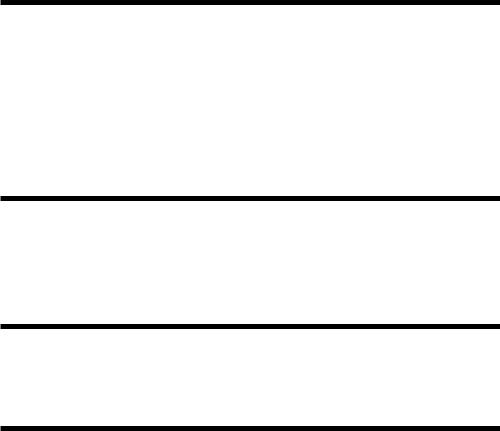
Installation and Wiring 2.1
Read these instructions carefully before proceeding with installation and operation. Electrical code requirements and safety standards should be observed. Installation should be performed by qualified personnel.
CAUTION: The Instrument AC power input is specified in the model number and on the wiring label affixed to the the top center of the platen. Verify the AC power input required by the instrument prior to proceeding with installation.
Unpacking 2.2
Remove the instrument from the carton and inspect for any damage due to shipment. If any damage is noticed due to transit, report and file a claim with the carrier. Write the model number and serial number of the instrument on the inside of the front cover of this Operation Manual for future reference.
Location 2.3
Locate the instrument away from excessive moisture, oil, dust, and vibration. Do not subject the instrument to operating temperatures outside of the 32°F to 131°F (0°C to 55°C) range.
Mounting 2.4
Figure 2-1A and 2-1B (below and page 2) shows an installation view and physical dimensions for a panel mounted instrument. The panel where the instrument will be mounted must provide rigid support for the approximately 25 pound instrument. Adjacent instruments may be mounted within a minimum of 2 inches horizontally and 1 inch vertically, providing that proper panel support is supplied.
Panel Mounting Hardware Required: (not provided with instrument)
(4) #10 flat head bolts with nuts
(4) lock washers
Panel Mounting
1.Cut panel opening to the dimensions illustrated in Figure 2-1A (below).
2.Pre-drill four 3/16 dia. holes for mounting or use the drill template molded into the case after inserting the instrument into the panel.
3.Insert the instrument in the panel opening. Firmly fasten the instrument to the panel using the nuts, bolts and lock washers.
Surface Mounting
Install the mounting brackets, ordered separately, on the vertical sides of instrument housing. Use the brackets to fasten the instrument to the surface. Hardware recommended - #10-24 SCRs.
8
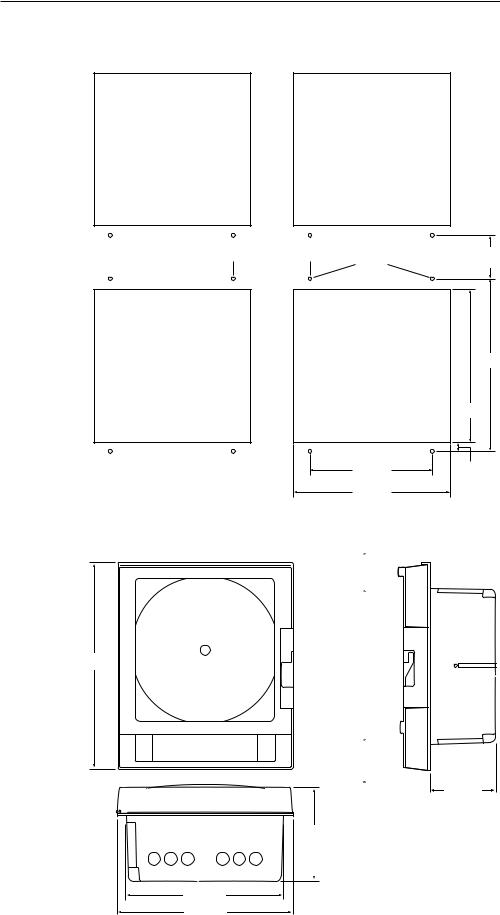
FIGURE 2-1
Figure 2-1A
(MIN. HORZ. SPACING)
 6.156"
6.156"  3/16" DIA. (156.36mm)
3/16" DIA. (156.36mm)
10.000"
(254.00mm)
12.700"
(322.58mm)
Figure 2-1B
2.12"
(53.85mm)
17.04" |
12.60" |
(432.82mm) |
(320.04mm) |
2.044"
(58.93mm)
|
|
|
7.747" |
|
|
|
|
(196.77mm) |
|
|
EC5 |
|
EC6 |
|
EC1 |
EC2 |
EC3 |
EC4 |
|
|
|
|
|
|
12.600"
(320.04mm)
14.12"
(358.65mm)
(MIN. VERT. SPACING) 3.600"
(91.44mm)
14.180"
(360.17mm)
12.700"
(322.58mm)
0.7"
(17.78mm)
5.24"
(133.10mm)
9

Preparations for Wiring 2.5
2.5.1 WIRING GUIDELINES
Electrical noise is a phenomenon typical of industrial environments. The following are guidelines that must be followed to minimize the effect of noise upon any instrumentation.
2.5.1.1 INSTALLATION CONSIDERATIONS
Listed below are some of the common sources of electrical noise in the industrial environment:
•Ignition Transformers
•Arc Welders
•Mechanical contact relay(s)
•Solenoids
Before using any instrument near the devices listed, the instructions below should be followed:
1.If the instrument is to be mounted in the same panel as any of the listed devices, separate them by the largest distance possible. For maximum electrical noise reduction, the noise generating devices should be mounted in a separate enclosure.
2.If possible, eliminate mechanical contact relay(s) and replace with solid state relays. If a mechanical relay being powered by an instrument output device cannot be replaced, a solid state relay can be interposed to isolate the instrument. (Continued on next page)
3.A separate isolation transformer to feed only instrumentation should be considered. The transformer can isolate the instrument from noise found on the AC power input.
4.If the instrument is being installed on existing equipment, the wiring in the area should be checked to insure that good wiring practices have been followed.
2.5.1.2AC POWER WIRING
Earth Ground
The instrument includes noise suppression components that require an earth ground connection to function. To verify that a good earth ground is being attached, make a resistance check from the instrument chassis to the nearest metal water pipe or proven earth ground. This reading should not exceed 100 ohms. Each instrument should have a dedicated earth ground. Do not chain link multiple instrument ground wires.
Neutral (For 115VAC)
It is good practice to assure that the AC neutral is at or near ground potential. To verify this, a voltmeter check between neutral and ground should be done. On the AC range, the reading should not be more than 50 millivolts. If it is greater than this amount, the secondary of this AC transformer supplying the instrument should be checked by an electrician. A proper neutral will help ensure maximum performance from the instrument.
2.5.1.3 WIRE ISOLATION/SEGRATION
The instrument is designed to promote proper separation of the wiring groups that connect to the instrument. The AC power wire terminals are located near the top of the instrument boards. The analog signal terminals are located near the bottom of the instrument boards. Maintain this separation of the wires to insure the best protection from electrical noise. If the wires need to be run parallel with any other wiring type(s), maintain a minimum 6 inch space between the wires. If wires must cross each other, do so at 90 degrees to minimize the
10
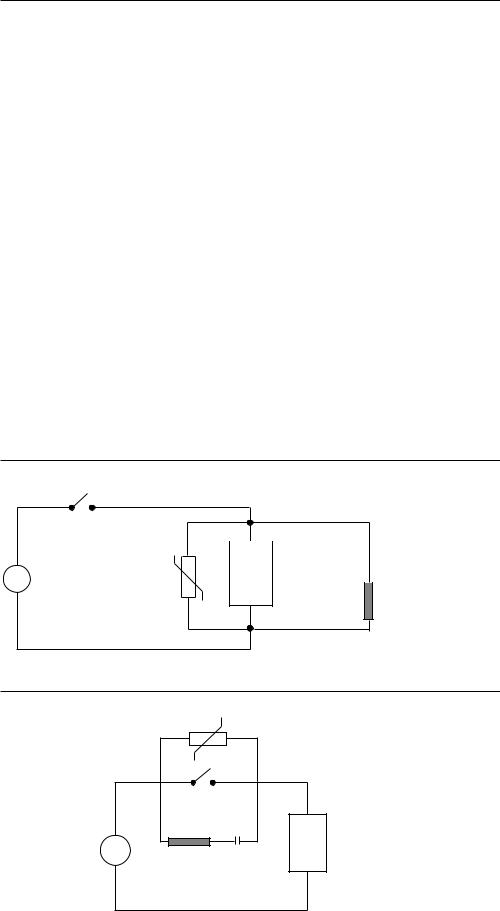
contact with each other and amount of cross talk. Cross talk is due to the EMF (Electro Magnetic Flux) emitted by a wire as current passes through it.
2.5.1.4 USE OF SHIELDED CABLE
Shielded cable helps eliminate electrical noise being induced on the wires. All analog signals should be run with shielded cable. Connection lead length should be kept as short as possible, keeping the wires protected by the shielding. The shield should be grounded at one end only. The preferred grounding location is at the sensor, transmitter or transducer.
2.5.1.5 NOISE SUPPRESSION AT THE SOURCE
Usually when good wiring practices are followed, no further noise protection is necessary. Sometimes in severe environments, the amount of noise is so great that it has to be suppressed at the source. Many manufacturers of relays, contactors, etc. supply "surge suppressors" which mount on the noise source.
For those devices that do not have surge suppressors supplied, RC (resistance-capacitance) networks and/or MOV (metal oxide varistors) may be added.
Inductive Coils - MOV's are recommended for transient suppression in inductive soils connected in parallel and as close as possible to the coil. See Figure 2-2. Additional protection may be provided by adding an RC network across the MOV.
Contacts - Arcing may occur across contacts when the contact opens and closes. This results in electrical noise as well as damage to the contacts. Connecting a RC network properly sized can eliminate this arc.
For circuits up to 3 amps, a combination of a 47 ohm resistor and 0.1 microfarad capacitor (1000 volts) is recommended. For circuits from 3 to 5 amps, connect 2 of these in parallel. See Figure 2-3.
FIGURE 2-2
|
|
|
|
|
|
|
C |
0.5 |
|
|
|
|
|
|
|
mfd |
|
|
|
|
|
|
|
|
||
|
|
|
|
|
|
|
||
|
|
|
Inductive |
1000V |
||||
A.C. |
MOV |
|
|
|||||
|
Load |
|
|
|
|
|||
|
|
|
|
|
|
|||
R 220 ohms
115V 1/4W
230V 1W
FIGURE 2-3 |
MOV |
|
A.C. |
|
|
Inductive |
R |
C |
Load |
11

2.5.2 SENSOR PLACEMENT (THERMOCOUPLE OR RTD)
If the temperature probe is to be subjected to corrosive or abrasive conditions, it should be protected by the appropriate thermowell. The probe should be positioned to reflect true process temperature:
In liquid media - the mose agitated area.
In air - the best circulated area.
THERMOCOUPLE LEAD RESISTANCE
Thermocouple lead length can affect instrument accuracy, since the size (gauge) and the length of the wire affect lead resistance.
To determine the temperature error resulting from the lead length resistance, use the following equation:
Terr = TLe * L |
where; TLe = value from appropriate Table |
|
L = length of leadwire in thousands of feet. |
TABLE 1
Temperature error in °C per 1000 feet of Leadwire
AWG |
Thermocouple Type |
|
|
|
|
|
|
|
||
No. |
J |
K |
T |
R |
S |
E |
B |
N |
C |
|
10 |
.68 |
1.71 |
.76 |
2.05 |
2.12 |
1.15 |
14.00 |
2.94 |
2.53 |
|
12 |
1.08 |
2.68 |
1.21 |
3.30 |
3.29 |
1.82 |
22.00 |
4.68 |
4.07 |
|
14 |
1.74 |
4.29 |
1.95 |
5.34 |
5.29 |
2.92 |
35.00 |
7.44 |
6.37 |
|
16 |
2.74 |
6.76 |
3.08 |
8.30 |
8.35 |
4.60 |
55.50 |
11.82 |
10.11 |
|
18 |
4.44 |
11.00 |
5.00 |
13.52 |
13.65 |
7.47 |
88.50 |
18.80 |
16.26 |
|
20 |
7.14 |
17.24 |
7.84 |
21.59 |
21.76 |
11.78 |
141.00 |
29.88 |
25.82 |
|
24 |
17.56 |
43.82 |
19.82 |
54.32 |
54.59 |
29.67 |
356.50 |
75.59 |
65.27 |
|
|
|
|
|
|
|
|
|
|
|
|
TABLE 2
Temperature error in °F per 1000 feet of Leadwire
AWG |
Thermocouple Type |
|
|
|
|
|
|
|
||
No. |
J |
K |
T |
R |
S |
E |
B |
N |
C |
|
10 |
1.22 |
3.07 |
1.37 |
3.68 |
3.81 |
2.07 |
25.20 |
5.30 |
4.55 |
|
12 |
1.94 |
4.82 |
2.18 |
5.93 |
5.93 |
3.27 |
39.60 |
8.42 |
7.32 |
|
14 |
3.13 |
7.73 |
3.51 |
9.61 |
9.53 |
5.25 |
63.00 |
13.38 |
11.47 |
|
16 |
4.93 |
12.18 |
5.54 |
14.93 |
15.04 |
8.28 |
99.90 |
21.28 |
18.20 |
|
18 |
7.99 |
19.80 |
9.00 |
24.34 |
24.56 |
13.44 |
159.30 |
33.85 |
29.27 |
|
20 |
12.85 |
31.02 |
14.12 |
38.86 |
39.18 |
21.21 |
253.80 |
53.79 |
46.48 |
|
24 |
31.61 |
78.88 |
35.67 |
97.77 |
98.26 |
53.40 |
641.70 |
136.07 |
117.49 |
|
Example
A recorder is to be located in a control rrom 660 feet away from the process. Using 16 AWG, Type J thermocouple, how much error is induced?
Terr = TLe * L = 4.93 (°F/1000 ft) from Table 2.
Terr = 4.93 (°F/1000 ft)
Terr = 3.3 °F
12
RTD LEAD RESISTANCE
RTD lead length can affect instrument accuracy. Size (gauge) and length of the wire used affects lead length resistance.
To determine the temperature error resulting from the lead length resistance, use the following equation:
Terr = TLe * L |
where; |
TLe = value from Table 3 if 3 wire or Table 4 is 2 wire. |
||||||
|
|
|
|
L = length of leadwire in thousands of feet. |
||||
TABLE 3 |
3 Wire RTD |
|||||||
|
|
|
|
|
|
|
|
|
|
AWG No. |
Error °C |
|
|
Error °F |
|
|
|
|
10 |
|
+/-0.04 |
|
+/-0.07 |
|
|
|
|
12 |
|
+/-0.07 |
|
+/-0.11 |
|
|
|
|
14 |
|
+/-0.10 |
|
+/-0.18 |
|
|
|
|
16 |
|
+/-0.16 |
|
+/-0.29 |
|
|
|
|
18 |
|
+/-0.26 |
|
+/-0.46 |
|
|
|
|
20 |
|
+/-0.41 |
|
+/-0.73 |
|
|
|
|
24 |
|
+/-0.65 |
|
+/-1.17 |
|
|
|
TABLE 4 |
2 Wire RTD |
|||||||
|
|
|
|
|
|
|
|
|
|
AWG No. |
|
Error °C |
|
|
Error °F |
|
|
|
10 |
|
+/-5.32 |
|
+/-9.31 |
|
|
|
|
12 |
|
+/-9.31 |
|
+/-14.6 |
|
|
|
|
14 |
|
+/-13.3 |
|
+/-23.9 |
|
|
|
|
16 |
|
+/-21.3 |
|
+/-38.6 |
|
|
|
|
18 |
|
+/-34.6 |
|
+/-61.2 |
|
|
|
|
20 |
|
+/-54.5 |
|
+/-97.1 |
|
|
|
|
24 |
|
+/-86.5 |
|
+/-155.6 |
|
|
|
|
|
|
|
|
|
|
|
|
Example
An application uses 2000 feet of 18 AWG copper lead wire for a 3-wire RTD sensor. What is the worst-case error due to this leadwire length?
Terr = TLe * L
TLe = +/- .46 (°F/1000 ft) from Table 1
Terr = +/- .46 (°F/1000 ft) * 2000 ft
Terr = +/- 0.92 °F
13

Wiring Connections 2.6
All wiring connections are typically made to the instrument at the time of installation. Connections are made at the terminal boards provided, two 12 gauge wires maximum. Terminal boards are designated TB1 through TB13. See Figure 2-4 for the terminal board locations. The number of terminal boards present on the instrument depend upon the model number/ hardware configuration.
FIGURE |
2-4 |
|
|
|
|
|
|
|
|
|
|
|
|
|
|
|
|
|
|
|
|
|
|
|
|
|
|
|
|
|
|
|
|
|
|
||||||
|
|
|
|
|
|
|
|
|
|
|
|
|
|
|
|
|
|
|
|
|
|
|
|
|
|
|
|
|
|
|
|
|
|
|
|
|
|
|
|
|
|
|
|
|
|
|
|
|
|
|
|
|
|
|
1 2 |
|
|
1 |
2 |
3 |
4 |
1 |
2 3 |
|
4 |
||||||||||||||||||
|
|
|
|
|
|
|
|
|
|
|
|
|
|||||||||||||||||||||||||||||
|
|
|
|
|
|
|
|
|
|
|
|
|
|
|
|
|
|
|
|
|
|
|
|
|
|
|
|
|
|
|
|
|
|
|
|
|
|
|
|
|
|
|
|
|
|
|
|
|
|
|
|
|
|
|
|
|
|
|
|
TB1 |
|
|
|
TB6 |
|
|
|
|
TB7 |
|
|||||||||||||
|
|
|
|
|
|
|
|
|
|
|
|
|
|
|
|
|
|
|
|
|
|
|
|
|
RELAY/SSR Driver |
|
|||||||||||||||
|
|
|
|
|
|
|
|
|
|
|
|
|
|
|
|
|
|
|
|
|
|
|
|
|
Board |
|
|
|
|
|
|
|
|
|
|
|
|
||||
|
|
|
|
|
|
|
|
Processor Board |
|
|
|
|
|
|
|
|
|
|
|
|
|
|
|
|
|
|
|
||||||||||||||
|
|
|
|
|
|
|
|
|
|
|
|
|
|
|
|
|
|
|
|
|
|
|
|
|
|
|
|
|
|
|
|
|
|
|
|
|
|
|
|
|
|
|
|
|
|
|
|
|
|
|
|
|
|
|
|
|
|
|
|
|
|
|
|
|
|
|
|
|
|
|
|
|
|
|
|
|
|
|
|
|
|
|
|
|
|
|
|
|
|
|
|
|
|
|
|
|
|
|
|
|
|
|
|
|
|
|
|
|
Current Output Board |
|
|||||||||||||||
|
|
TB 2 |
|
|
|
|
|
|
|
|
|
|
|
|
|
|
|
|
|
|
|
|
|
|
|
|
|
|
|
|
|
|
|
|
|
|
|||||
|
|
|
|
|
|
|
|
|
|
|
|
|
|
|
|
|
|
|
|
|
|
|
|
|
|
|
|
|
|
|
|
|
|
|
|
|
|
|
|||
|
|
|
|
|
|
|
|
|
|
|
|
|
|
|
|
|
|
|
|
|
|
|
|
|
|
|
|
|
|
|
|
|
|
|
|
|
|
|
|
|
|
|
1 |
2 |
|
|
|
|
|
|
|
|
|
|
|
|
|
|
|
|
|
|
|
|
|
|
TB8 |
|
|
TB9 |
|
||||||||||||
|
|
|
TB3 |
|
TB4 |
|
|
TB5 |
|
|
|
|
|
|
|
|
|||||||||||||||||||||||||
|
|
|
|
|
|
|
|
|
|
|
|
|
|
|
|
|
|
|
|
|
|
|
|
|
|
|
|
|
|
|
|
|
|
|
|
|
|||||
|
|
|
1 2 |
|
1 2 3 4 5 |
|
1 2 3 4 5 |
|
|
|
|
|
|
1 |
|
2 |
1 |
|
|
2 |
|
|
|
||||||||||||||||||
2.6.1 ELECTRICAL CONDUIT OPENINGS
The instrument case will have 3 or 4 conduit openings, depending upon the number of outputs specified. To help minimize electrical noise that may adversely affect the operation of the instrument the wires indicated below should be routed through the conduit opening specified. See Figure 2-1 (page 9) for conduit opening locations.
EC4- |
AC Power Input |
EC1/EC2- |
Analog input and mADC outputs |
EC3/EC4- |
SPST relay or SSR driver outputs |
Unused conduit openings should be sealed.
2.6.2 AC POWER WIRING CONNECTIONS
WARNING: Avoid electrical shock. AC power wiring must not be connected at the source distribution panel until all wiring connections are completed.
14
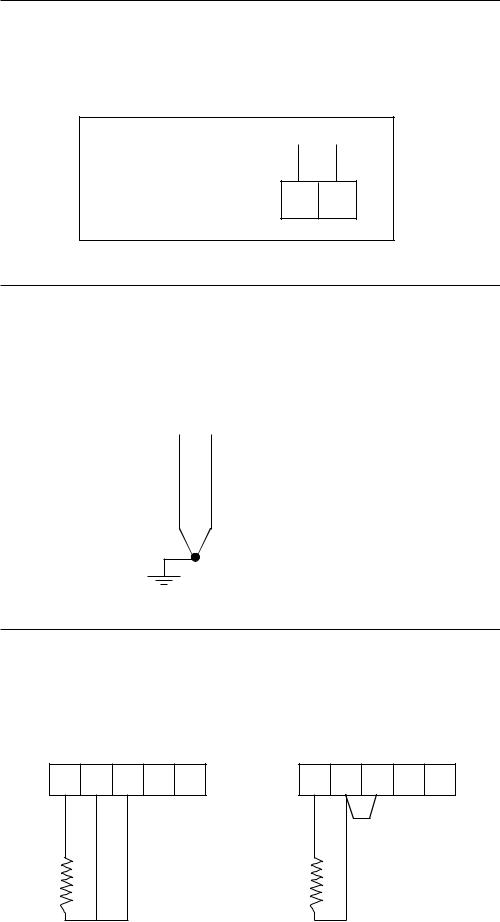
FIGURE 2-5
AC Instrument Power Input
Connect the 115 VAC hot and neutral to terminals 1 and 2 respectively of TB1. See Figure 2-4 (page 14) for Terminal Board locations on the instrument. Connect the 230 VAC one leg to each terminal, be sure to check the position of the Voltage Selector switch provided with 230 VAC instruments. The switch position must match the voltage input to the instrument.
Connect the AC ground at the  green ground screw on the top right side of the inside of the case
green ground screw on the top right side of the inside of the case
Line 1 |
TB1 |
Line 2 |
1 2
FIGURE 2-6
Thermocouple Inputs
Use TB4 for the Pen 1 input, and TB5 for the Pen 2 input. Connect the positive leg of the thermocouple to terminal 1, and the negative to terminal 2. Be sure that the input conditioning jumpers are properly positioned for a thermocouple input. See Appendix A-1 (page 62).
TB4 or TB5
+ |
- |
3 |
4 |
5 |
1 |
2 |
|||
|
|
|
|
|
Grounded or Ungrounded Thermocouples may be used
FIGURE 2-7
RTD Inputs
Use TB4 for the Pen 1, and TB5 for the Pen 2 input. Connections are shown for 3 wire and 2 wire RTD inputs. If a three wire device is used, install the common legs to terminals 2 and 3. If a two wire device is used, install a jumper between terminals 2 and 3. Be sure that the input conditioning jumpers are properly positioned for an RTD input. See Appendix A-1 (page 62).
|
TB4 or TB5 |
|
|
TB4 or TB5 |
|
||||
+ |
- |
3 |
4 |
5 |
+ |
- |
3 |
4 |
5 |
1 |
2 |
1 |
2 |
||||||
|
|
|
|
|
|
|
|
Jumper |
|
|
|
|
|
|
|
|
|
SUPPLIED BY |
|
|
|
|
|
|
|
|
|
CUSTOMER |
|
|
|
|
3 Wire RTD |
|
|
2 Wire RTD |
|||
15
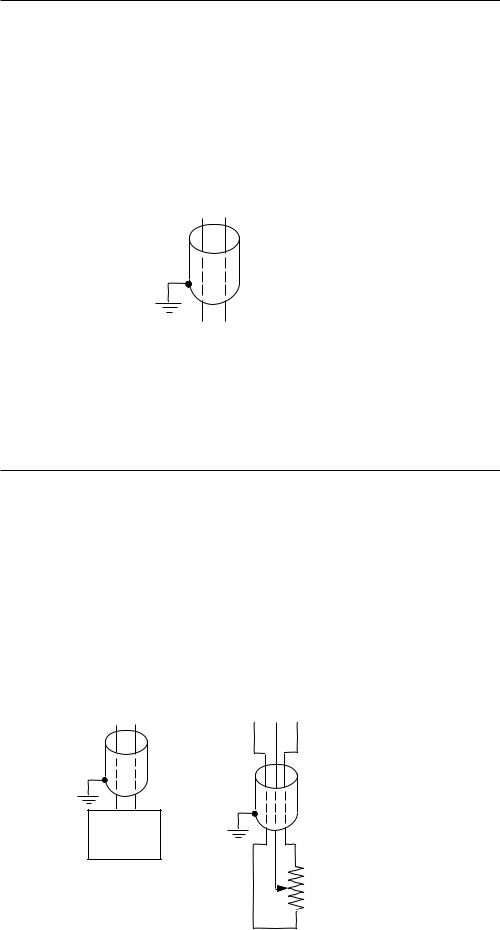
FIGURE 2-8
Volt, Millivolt and milliamp Input
Make the volt, millivolt and milliamp connections as shown below. Use TB4 for thePen 1 input, and TB5 for the Pen 2 input. Terminal 1 is positive and terminal 2 is negative. The milliamp input requires the installation of an appropriate shunt resistor (ordered separately) between terminals 1 and 2. Be sure that input conditioning jumpers are in the correct positions for the input being connected. See Appendix A-1 (page 62).
NOTE: Fault Detection is not functional for 0-5V or 0-20mA inputs.
TB4 or TB5
+ |
- |
3 |
4 |
5 |
1 |
2 |
SHIELDED
TWISTED
PAIR
|
|
|
|
|
|
|
+ - |
MAY BE |
|
|
|
|
|
|
|
SOURCE |
GROUNDED |
|
|
|
|
|
|
|
OR |
|
|
|
|
|
|
|
|
||
|
|
|
|
|
|
|
|
UNGROUNDED |
|
|
|
|
|
|
|
|
|
|
|
|
|
|
|
|
|
FIGURE 2-9
Remote Setpoint Input VDC , mADC
If Remote Setpoint option has been specified, make connections as shown. The remote setpoint input may be selected as either 0 to 5 VDC or 1 to 5 VDC input in the Program mode section. Make sure the configuration properly matches the input used. Use TB4 for Pen 1, and TB5 for Pen 2 if Pen 2 is provided and specified with the Remote Setpoint option. Connect the positive lead to terminal 4, and the negative lead to terminal 3 (Terminal 3 is the ground, terminal 4 is the input, terminal 5 is 5 VDC.) If a 4 to 20 mADC remote setpoint is to be used, the instrument remote setpoint input should be configured for 1 to 5VDC in the Program mode, and a 250 ohm resistor should be installed across terminals 4 and 3. A 250 ohm resistor is provided with the instrument, one per pen. The resistor(s) are shipped in the plastic bag that is clipped to the inside of the instrument cover. This is the same bag that contains the spare pen cartridge(s).
TB4 or TB5
+ |
- |
3 |
4 |
5 |
1 |
2 |
TB4 or TB5
+ |
- |
3 |
4 |
5 |
1 |
2 |
SHIELDED |
|
TWISTED |
SHIELDED |
PAIR |
|
|
MULTI-CONDUCTOR |
- + |
CABLE |
|
|
SOURCE |
150 OHM |
|
|
|
TO 10K OHM |
|
POTENTIOMETER |
16
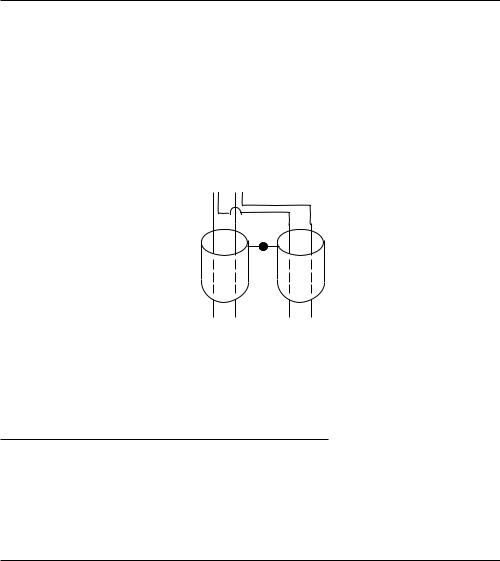
FIGURE 2-10
Digital Communications Options
Connections are made as shown using TB2. Refer to the Protocol Manual, Form #2878 for more details regarding the connections and how to use this option. This document is provided only when this option has been specified. If the communications network continues on to other instruments, connect the cable shields together, but not to the instrument. A terminating resistor should be installed at the terminals of the last unit in the communications loop. If the communications network ends at the instrument, the shield is not connected.
TB2
Serial A |
1 |
2 |
Serial B |
|
|
||
|
|
|
|
TOWARD THE |
NETWORK |
COMPUTER |
CONTINUATION |
|
(IF APPLICABLE) |
2.6.4 OUTPUT CONNECTIONS
Relay output(s), if provided in the instrument, may be assigned to control or alarm output functions for Pen 1 and/or Pen 2 (if present). Current outputs may be assigned to control and process value retransmission output for Pen 1 and/or Pen 2 (if present). The assignment of the output function (s) are/is accomplished in the Program mode. SPST relay and/or SSR driver output(s) is/are designated as Relay A through Relay D.
FIGURE 2-11
SPST Relay Output
Connections are made to relays A through D as shown. Terminal connections are made using TB6 (Relay/SSR Driver A, B) and TB7 (Relay/SSR Driver C, D).
|
|
|
|
|
|
|
|
|
HOT |
POWER |
|
|
|
|
|
|
|
|
|
|
NEU |
||
|
|
|
|
|
|
|
|
|
|
|
|
|
|
|
|
|
|
|
|
|
|
|
|
|
|
|
|
|
|
|
LOAD |
5 AMPERES |
|||
|
|
|
|
|
|
|
|
|
|
||
1 |
2 |
3 |
4 |
|
|
|
|
MAXIMUM |
|||
N.O. |
C |
N.O. |
C |
|
|
|
|
AT 115 VAC |
|||
TB6 Relay A & B, Relay A Terminals 1 & 2
TB7 Relay C & D, Relay C Terminals 1 & 2
17
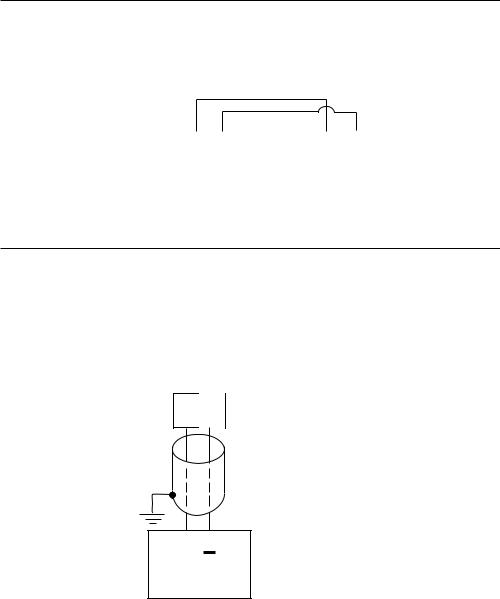
FIGURE 2-12
SSR Driver Output
Connections are made to relays D through A as shown. Terminal connections are made using TB7 and TB6, depending on the number of SSR Driver outputs specified.
|
1 |
2 |
3 |
4 |
|
+ - |
|
|
|
|
|
|
|
SSR |
|
TB6 |
OR |
TB7 |
|||||
|
|||||||
|
|
|
|
|
|
|
|
FIGURE 2-13
Current Output
Connections are made to current outputs A and B as shown. Each current output is programmable as either 4 to 20 mADC or 0 to 20 mADC. Each output must be assigned to the desired function in the Program mode. Terminal connections are made using TB8 and TB9 for current output A and B respectively. Connect positive lead (+) to terminal 1 and the negative lead (-) to terminal 2. Each current output will operate up to a 650 ohms maximum load.
1 2
SHIELDED
TWISTED
PAIR
+
650 OHMS LOAD MAXIMUM
18
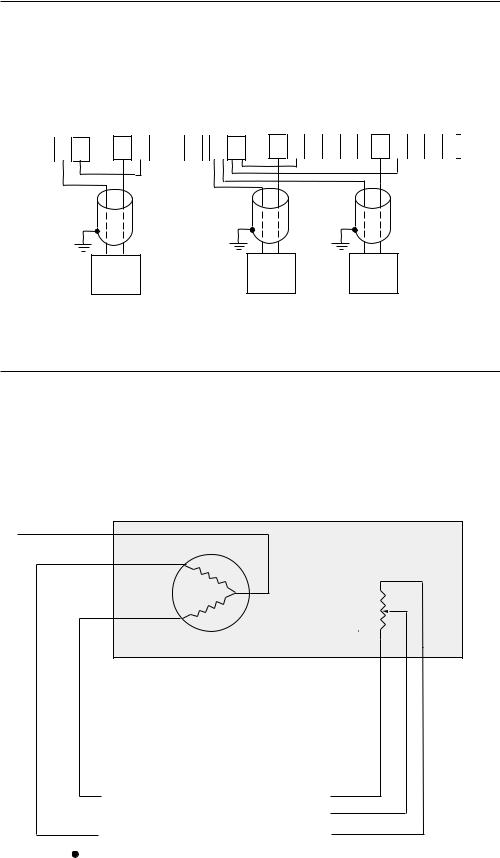
FIGURE 2-14
Transmitter Power Supply Input
If the isolated 24 VDC regulated transmitter power supply has been specified, the connections should be made as shown. Connections are made using TB3, terminal 1 is positive and terminal 2 is negative. The power supply is capable of providing the power needed by up to 2 transducers (40 mADC maximum).
TB3 |
|
TB4 or TB5 |
|
TB3 |
+ |
|
TB4 |
|
|
+ |
|
TB |
|
|
||||
+ |
- |
+ |
- |
3 |
4 |
5 |
+ |
- |
- |
3 |
4 |
5 |
- |
3 |
4 |
5 |
||
1 |
2 |
1 |
2 |
1 |
2 |
1 |
2 |
1 |
2 |
|||||||||
|
|
|
|
SHIELDED |
|
|
|
|
|
|
|
|
|
|
|
|||
|
|
|
|
|
TWISTED |
|
|
|
|
|
|
|
|
|
|
|
|
|
|
|
|
|
|
PAIRS |
|
|
|
|
|
|
|
|
|
|
|
|
|
|
|
+ |
|
|
|
|
|
|
+ |
|
|
|
|
+ |
|
|
|
|
|
TWO WIRE |
|
|
|
|
TWO WIRE |
|
|
TWO WIRE |
|
|
|
||||||
TRANSMITTERS |
|
|
|
TRANSMITTERS |
TRANSMITTERS |
|
|
|||||||||||
FIGURE 2-15
Position Proportioning Control Output
Position Proportioning control requires that two relays (or SSR Drivers) and the Position Proportioning Auxiliary input be specified. On a dual pen instrument, either pen may be configured with Position Proportioning control provided the outputs and auxiliary inputs have been properly specified.
L2
OPEN |
L |
|
|
CLOSE |
C |
|
|
|
H |
|
|
|
|
Modulating Motor |
|
Slidewire |
|
|
|
|
|
|
Feedback |
|
|
|
|
|
|
Resistance |
|
|
|
|
|
|
min. 135 |
|
|
|
|
|
|
ohms |
|
|
|
|
|
|
max. 10K |
|
|
|
|
|
|
ohms |
|
|
|
|
TB4 |
|
|
|
|
4 |
|
5 |
|
|
|
|
TB6 or |
or |
|
||
|
|
3 |
TB7 |
TB5 |
4 |
|
|
|
|
|
|
||
|
|
|
|
|
|
|
|
|
2 |
|
|
3 |
|
|
|
|
|
|
|
|
|
|
1 |
|
|
|
|
|
|
|
|
|
|
|
|
|
|
|
|
|
|
L1
19
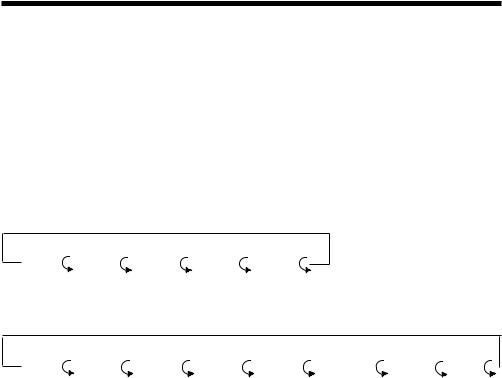
Configuration 3.1
After completing installation and wiring of the instrument the configuration (set up) procedures must be performed to prepare the instrument for operation on the intended application. The procedures include selecting specific parameters, entering data and possible jumper positioning. Once properly configured the instrument will retain the user selections in memory so this procedure need not be repeated unless required by changes in the application.
Parameter selections and data entry are made via the front keypad. To ease configuration and operation, user entered data has been divided up into several sections referred to as modes. Each mode contains a different type of data or may be used for specific operating functions. For two pen instruments, some modes are common to both pens. These modes are as follows:
RECORDER-
Operation |
Test |
Calibrate |
Program |
Alarm Set |
(oPEr) |
(tESt) |
(CAL) |
(Prog) |
(ASEt) |
RECORDING CONTROLLER-
Control |
Test |
Calibrate |
Program |
Tune |
Setpoint Select |
Standby |
OFF |
(CtrL) |
(tESt) |
(CAL) |
(Prog) |
(tunE) |
(SPS) |
(Stby) |
(oFF) |
MODE |
DISPLAY CODE |
FUNCTION |
DESCRIPTION |
|
Off |
|
oFF |
Operation |
Outputs and Alarms |
|
|
|
|
are Off |
|
|
|
|
Chart may stop |
|
|
|
|
rotating(selectable) |
Operate* |
|
oPEr |
Operation |
Limits and Alarms |
|
|
|
|
are Active |
Control** |
|
CtrL |
Control |
Outputs and Alarms |
|
|
|
|
are Active |
Test |
|
tESt |
Service |
Tests Instrument |
|
|
|
|
Operation |
Calibration |
|
CAL |
Service |
Calibrates, Resets |
|
|
|
|
Instrument |
Program |
|
Prog |
Configuration |
Configure Operating |
|
|
ASEt |
|
Parameters |
Alarm Set* |
|
Configuration & |
Enter Alarm Settings |
|
|
|
|
Operation |
|
Tune** |
|
tunE |
Configuration & |
Enter Tune and |
|
|
|
Operation |
Alarm Settings |
Setpoint Selection** |
SPS |
Operation |
Selects Remote or |
|
|
|
|
|
Local Setpoint |
Operation (Remote
Setpoint Optional)
*Applies to Recorders
**Applies to Recording Controllers
20
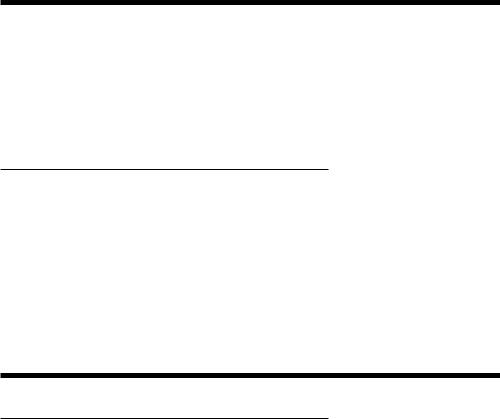
Manual** |
Stby |
Operation |
Provides for manual |
|
|
|
operation of |
|
|
|
proportional output |
Enable |
EnAb |
Configuration |
Mode security |
|
|
|
system, can lock out |
|
|
|
everything except Off |
|
|
|
and Control (See |
|
|
|
Appendix A-1, page |
|
|
|
62, for hardware |
|
|
|
lockout information) |
*Applies to Recorders
**Applies to Recording Controllers
Associated with each mode is a series of unique displays that are accessed via the front keypad.
Prior to first time operation of the instrument, the configuration procedures for the Program and Tune modes must be performed as applicable. Calibration and Test modes are not used as part of the instrument configuration or operation. These are used for service and maintenance functions and are discussed in Section 5.4 & 5.5 of this manual (page 46 - 54).
Shipped Configuration/Jumper Positioning 3.2
Each instrument is factory shipped ready to accept a thermocouple input on TB 4 and TB 5. All parameters in each mode are set to default values. These defaults are shown in tabular form after the description for each mode. Instrument AC power input is as specified in the instrument model number and is shown on the ratings label. The 230 VAC option includes a switch in the instrument for selecting either 230 VAC or115 VAC input power. If this feature is provided, verify AC input and switch position before applying power to the instrument.
3.2.1 JUMPER POSITIONING
Jumpers are used to condition the sensor inputs and to provide a security lockout feature. All jumpers are located on the instrument Processor board. The instrument board layout and jumper locations and functions are shown in Appendix A-1 (page 62). Check the jumper positions in the instrument and verify that they are in the proper position for the intended application.
The sensor input jumpers JU4, JU5, JU6 and JU7 condition the sensor input signals and must be used in conjunction with input type selections made in the Program mode. (page 28).
Operation Summary 3.3
3.3.1 MODE SELECTION
If the instrument is either in the Off mode, the Operation mode (recorders), or the Control mode (recording controllers), repeated pressing and releasing of the SCROLL key will cause the instrument to display the code corresponding to each mode that is enabled. To enter a mode while the code is displayed, press the DOWN key. If a mode does not appear, refer to the Enable mode section for information on how to determine if the mode is on.
Entry into any mode except the Operate, Control, Tune, Manual, or Enable modes, will cause the output(s) to turn off and any process re-transmission value output(s) to be 0 %. Entry into the Off mode will cause process re-transmission to remain active.
21

Start up Procedures 3.4
All configuration parameters are listed in Tables 3-1 through 3-5.
For a single pen instrument, parameters for each mode are displayed in the left display. If the instrument being configured is a two pen model, a sequence of applicable parameters will be displayed in the Pen 2 display after the Pen 1 parameters have been reviewed and configured. After the Pen 2 parameters have been completed, parameters common to both pens will be configured and displayed in the Pen 1 display.
The instrument is provided with a time out feature. If the instrument is in any mode (except while executing a calibration or test procedure) and no keypad activity takes place for 30 seconds, the instrument will time out and exit the mode automatically. The display will become the code for the respective mode. If a mode code is displayed for 5 seconds with no keypad activity, then the time out will cause the instrument to proceed to either the Control or Off mode, depending upon whether the mode entered was an operational mode (Tune, Manual, Enable) or non operational mode (Test, Program, Cal).
3.4.1 POWER UP PROCEDURE
Step 1
Verify that all electrical connections have been properly made before applying power to the instrument.
Step 2
Upon power up, a brief flash on all displays (upper and, if equipped, lower) will occur to show the instrument is "alive". Then 8XXX will be displayed (X representing digits), then XXXX, then XXXX, identifying the twelve digit model number as defined in the order matrix. Next, the EPROM part number will be indicated P-XX. After the EPROM part number, the software revision level will be displayed in the format rX.XX followed by P.dn (if Pen Action on Power Up, PAPu, in Program Mode is set to 0, pens go to "home" position on power up). During this display, the decimal point after the "P" will blink to show the mode is active. Upon successful completion of this routine, CtrL, OPEr or oFF will be displayed for about three seconds. The mode displayed will be the mode that the instrument was in when the power was turned off. During this time the operator may select another mode (Tune, Manual, Enable) or nonoperational mode (Test, Program, Cal).
Step 3
If any error messages are displayed, refer to Section 5.6 (page 55) for a definition of the error message and the required action.
Front Panel Operation 3.5
3.5.1 DIGITAL DISPLAY AND STATUS LEDs
The digital display provided for each pen has 4 digits and a decimal point. Each digit has seven segments and is capable of producing numeric characters from 0-9 and certain alpha characters. The digital display is used to provide indication of process variable as well as displaying codes used for configuration and operation of the instrument. The display includes the following Status Indicator LED’s;
22

RECORDER: |
|
|
ALRM1 |
Red |
Rcdr - Lights when Alarm 1 is on. |
ALRM2 |
|
Limit - Lights when Limit has been exceeded. |
Red |
Lights when Alarm 2 is on. |
|
C |
Red |
Lights to indicate that the process value is in terms of |
|
|
degrees C (Celsius). |
F |
Red |
Lights to indicate that the process value is in terms of |
U |
|
degrees F (Fahrenheit). |
Red |
Lights to indicate that the process value is in terms of |
|
- |
|
Engineering units. |
Red |
Lights to indicate a negative displayed value. |
|
SP |
Green |
Indicates that the value displayed is the setpoint |
(Limits only) |
|
|
RECORDING CONTROLLER: |
||
MAN |
Amber |
Lights when the Manual StbY mode is on. |
OUT1 |
Red |
Lights when Output 1 is on or mADC output selected. |
OUT 2 |
Amber |
Lights when Output 2 is on or mADC output selected.. |
ALRM |
Red |
Lights when either Alarm is on. |
C |
Red |
Lights to indicate that the process value is in degrees C |
|
|
(Celsius). |
F |
Red |
Lights to indicate that the process value is in degrees F |
U |
|
(Fahrenheit). |
Red |
Lights to indicate that the process value is in terms of |
|
SP |
|
Engineering units. |
Green |
Indicates that the value displayed is the setpoint. |
|
- |
Red |
Lights to indicate a negative displayed value. |
Refer to Figure 1-2 (page 7) |
for the display features illustration. |
|
3.5.2 KEYPAD CONTROLS
The keys on the keypad functions include:
SCROLL: Used to : |
1. Display the enabled modes. |
|
|
2. |
While in a mode, used to sequence the parameter codes and |
|
|
values. |
|
3. |
Exit some Test and Calibration functions |
|
4. |
Work in conjunction with other keys: |
|
|
a. With the UP key to display proportional output % |
|
|
b. With the DOWN Key; |
|
|
1) On power up to alter model # |
|
|
2) Enter Cal/Test functions |
UP: Used to: |
1. |
Exit a mode. |
|
2. |
Turn a mode On in the Enable mode |
|
3. |
Increase a parameter numerical value |
|
4. |
View the setpoint for Pen 1 (Press release) |
|
5. |
Increase the setpoint value (Press hold) |
|
6. |
Work in conjunction with other keys: |
a. With the SCROLL key to display proportional output % b. With the DOWN key;
1) Lamp test (Press release)
2) Enter the Enable mode (Press and hold for 11 seconds)
23
